

FOI 24-31 - Doc 4
Environmental Management of Changes to
Aircraft Operations
AA-NOS-ENV-2.100
Version 11
Effective 1 February 2018
Prepared: s47F
Environmental Systems and Assurance
Manager
Endorsed
s47F
Standards and Systems Manager
Authorised: s47F
Executive General Manager, Safety and
Assurance
pursuant to the Freedom of Information Act 1982 by Airservices Australia
Released
Uncontrolled if printed
© Airservices Australia 2018
1 of 30
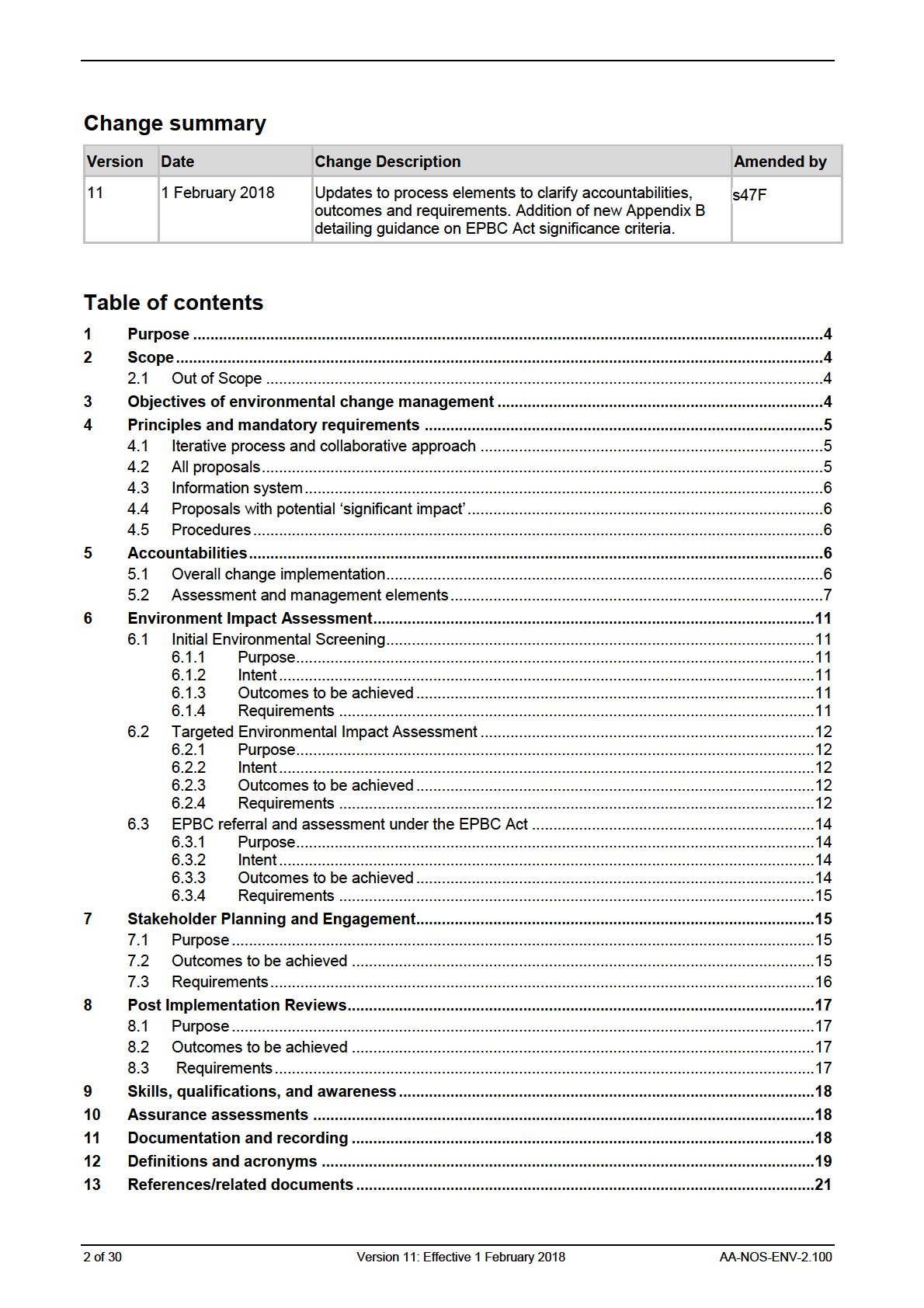
FOI 24-31 - Doc 4
pursuant to the Freedom of Information Act 1982 by Airservices Australia
Released
FOI 24-31 - Doc 4
13.1 Internal documentation ................................................................................................................. 21
13.2 External documentation ............................................................................................................... 21
Appendix A
Airservices Initial ANS Screening Criteria ............................................................... 22
Appendix B
Airservices Aviation Noise EPBC Act Referral Criteria for Environmental
Assessment of Changes to Aircraft Operations...................................................... 24
Appendix C
Other Business Revenue – explanatory notes ........................................................ 30
pursuant to the Freedom of Information Act 1982 by Airservices Australia
Released
AA-NOS-ENV-2.100
Version 11: Effective 1 February 2018
3 of 30
FOI 24-31 - Doc 4
1
Purpose
The purpose of this National Operating Standard (NOS) is to prescribe the
requirements for environmental impact assessment (EIA) and stakeholder planning and
engagement (including reputation management) that must be met by Airservices, prior
to the implementation of changes to aircraft operations.
These activities shall be collectively referenced as environmental change management
within this document.
Note: other commitments may apply to environmental change management, for
example as described in “Airservices Commitment to Aircraft Noise Management’
(2013) and ‘Airservices Communication and Consultation Protocol’ (2016), both
available on Airservices’ website.
2
Scope
This Standard applies to all Airservices proposed changes to air traffic management
practices (proposals) that may involve a change to aircraft operations.
Proposals include, but are not limited to, the following changes:
A new, or amendment to an existing, instrument approach;
A new, or amendment to an existing, flight path or air route;
Re-classification of airspace;
Change to preferred runways;
Change in time of day of operation (e.g. amendments to tower hours of
operation – the time of day that a tower operates may alter the flight path used
by aircraft);
A change that allows use of a flight path/airspace by a different type or number
of aircraft;
Note:
A tactical decision of an air traffic controller to alter the track of an individual
aircraft does not constitute a Proposal.
2.1
Out of Scope
This Standard does not necessarily apply to other business revenue (OBR) work
undertaken by Airservices. For OBR work, an approach shall be determined by the
Executive General Manager (EGM) Air Navigation Services (ANS), to assess the
potential application of the
Environmental Protection and Biodiversity Conservation Act
1999 (EPBC Act);and the potential environmental impact of the work.
Refer to Appendix A for applicable changes and Appendix C for further information
pursuant to the Freedom of Information Act 1982 by Airservices Australia
regarding OBR work.
3
Objectives of environmental change management
The main objectives of environmental change management for aircraft operations are
Released to:
1.
Meet Airservices’ legislative obligations to:
4 of 30
Version 11: Effective 1 February 2018
AA-NOS-ENV-2.100
FOI 24-31 - Doc 4
a.
minimise significant environmental impacts resulting from any Airservices
action, and ensure appropriate environmental assessments are
undertaken, as required under the EPBC Act.
b.
ensure air traffic management practices are conducted in a manner that
protects the environment, as far as is practicable, as required under the
Airservices Act 1995;
c.
meet Ministerial Directions relating to aircraft noise management;
2.
Minimise Airservices business risks by maintaining effective stakeholder
engagement and sound corporate citizenship in aircraft noise management;
3.
Provide a standardised and rigorous approach to assessing the impacts of
changes to aircraft operations, as a demonstration of organisational due diligence
in environmental management (in compliance with the requirements of
Airservices ISO:14001 aligned EMS - as described in AA-NOS-ENV-0001);
4.
Assist in achieving organisational environmental, sustainability and community
management commitments (as described in Airservices Environmental Policy C-
POL0030);
5.
Assist in achieving efficiency outcomes for Airservices customers, through
improved flight paths and associated reductions in fuel costs and emissions.
4
Principles and mandatory requirements
4.1
Iterative process and collaborative approach
Environmental change management is an iterative process involving risk assessment
and management; impact assessment (environmental, social and reputational); and
stakeholder and community engagement.
These management elements shall be conducted collaboratively and concurrently by
relevant accountable/responsible parties throughout the change lifecycle.
4.2
All proposals
Al proposed changes to Airservices’ air traffic management practices that may affect
aircraft operations shall:
1.
Be assessed for environmental impact prior to implementation;
2.
Undergo stakeholder engagement planning and stakeholder consultation prior to
implementation where potential community or environmental impacts are
identified;
3.
Be reassessed prior to implementation, if the proposal has already been impact
assessed in accordance with this NOS and:
pursuant to the Freedom of Information Act 1982 by Airservices Australia
a.
has subsequently been modified or;
b.
over 18 months has elapsed since the initial assessment process;
4.
Be undertaken in accordance with this National Operating Standard (NOS) and
subordinate procedures;
Released
5.
Seek to achieve a noise outcome which balances the needs of the community
and aviation industry stakeholders.
AA-NOS-ENV-2.100
Version 11: Effective 1 February 2018
5 of 30
FOI 24-31 - Doc 4
4.3
Information system
CIRRIS is Airservices information system which must be used to record case workflows
and due diligence activities associated with a change proposal.
The Environmental Systems and Assurance Manager is accountable to ensure that
CIRRIS accurately codifies the screening and assessment criteria and logic described
at Appendix A of this standard.
If CIRRIS is unavailable, change proposals shall be documented in a manner which
conforms to the criteria and process steps outlined in this standard.
4.4
Proposals with potential ‘significant impact’
Any proposal that results in an EPBC Act assessment finding of potential
‘significant
impact’, shall be referred, by the EGM ANS, to the Commonwealth Environment
Portfolio Minister (the Environment Minister) for advice, (unless the Accountable ANS
Manager decides not to proceed with the proposal).
Once advice is received from the Environment Minister:
the Environment Minister’s advice shall be considered by the CEO; and
the action taken (e.g. in relation to implementation of the proposal) shall be
recorded, and if the Minister’s advice was not given effect, the reasons why
shall be documented and forwarded to the Environment Minister by the CEO, in
accordance with the EPBC Act.
Refer to Section 6.3 for further information regarding EPBC Act referral assessment
requirements.
4.5
Procedures
Airservices business groups with accountabilities for planning and implementing
changes to aircraft operations (as indicated in this NOS) shall develop procedures that
describe:
The internal business processes required to enact the requirements of this
Standard (including interactions with other business groups and external
stakeholders);
The relevant methodologies for undertaking the environmental assessments
described in this standard;
The relevant methodologies for planning, undertaking and documenting
stakeholder engagement and community consultation.
5
Accountabilities
pursuant to the Freedom of Information Act 1982 by Airservices Australia
5.1
Overall change implementation
The ANS Group holds ultimate accountability for ensuring that no change proposal is
implemented without appropriate environmental impact assessment and stakeholder
management in accordance with this NOS.
Released In practice this means:
Project managing the change process to ensure that all assessment and
management elements are completed and endorsed by relevant managers;
6 of 30
Version 11: Effective 1 February 2018
AA-NOS-ENV-2.100
FOI 24-31 - Doc 4
Accepting or rejecting risk assessments (environmental and reputational) in
CIRRIS, produced during the environmental change management process (in
accordance with Airservices Risk Management Standard AA-NOS-RISK-0001);
Authorising implementation of the change once all environmental change
management requirements (as described in this NOS and any change specific
plans) have been met;
The Accountable ANS Manager is the clear point of accountability for the overall
success of a change. The Accountable ANS Manager is either:
o The Northern or Southern Operations Manager; or
o The EGM ANS (if the proposed change represents a class B risk for
environmental or reputational consequences1).
5.2
Assessment and management elements
Key elements and roles in the change management process are described in Table 1
below, and described in detail in Sections 6 and 7.
pursuant to the Freedom of Information Act 1982 by Airservices Australia
Released
1 To enable this, ANS shall maintain risk assessments (the “Ongoing Airport Noise Management Risk Assessment”) to
manage ongoing risks associated with noise management at specific Airports in addition to assessing the risk of change.
AA-NOS-ENV-2.100
Version 11: Effective 1 February 2018
7 of 30
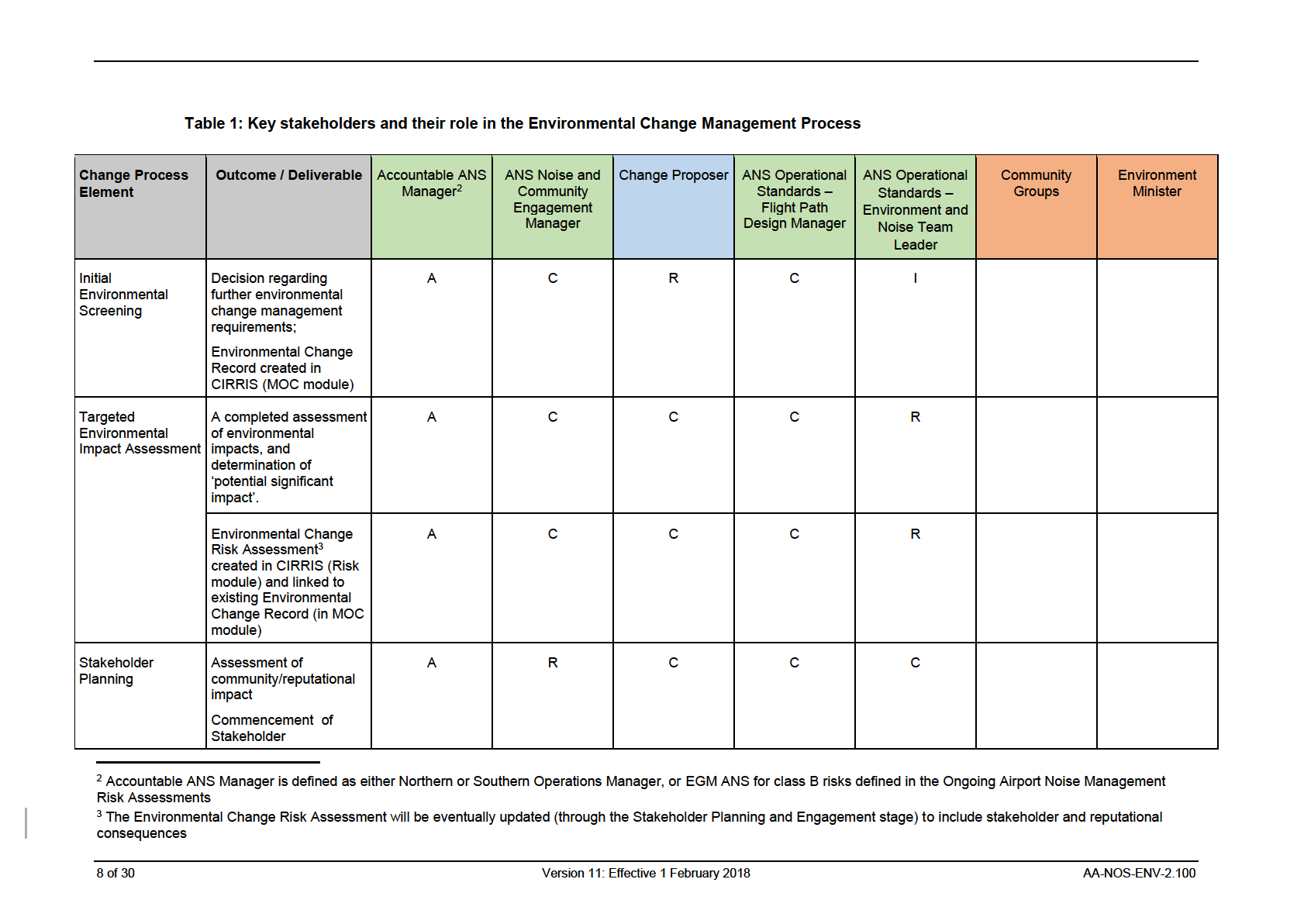
FOI 24-31 - Doc 4
pursuant to the Freedom of Information Act 1982 by Airservices Australia
Released
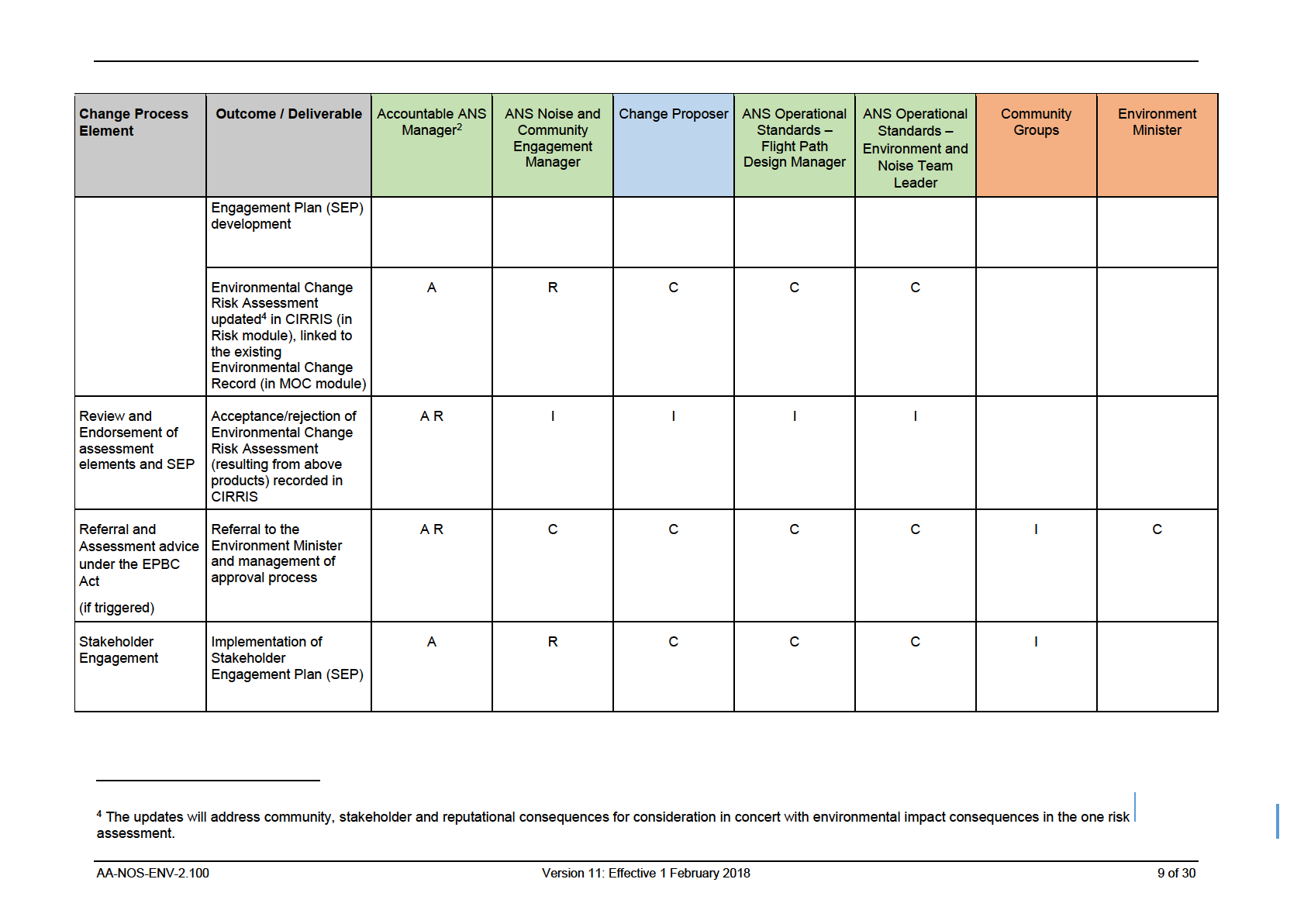
FOI 24-31 - Doc 4
pursuant to the Freedom of Information Act 1982 by Airservices Australia
Released
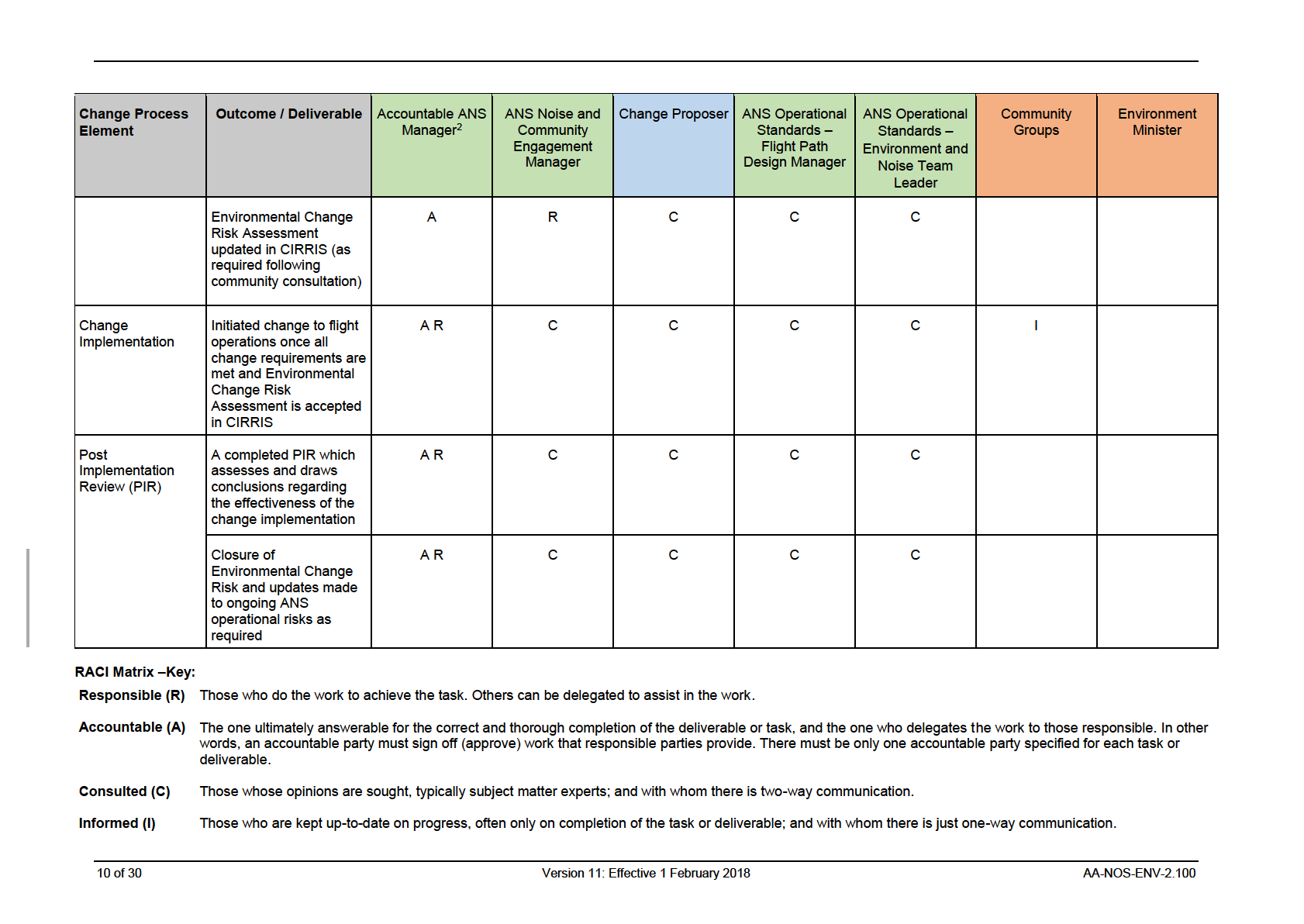
FOI 24-31 - Doc 4
pursuant to the Freedom of Information Act 1982 by Airservices Australia
Released
FOI 24-31 - Doc 4
6
Environment Impact Assessment
Environmental Impact Assessment (EIA) potentially includes three main stages, as
follows:
Stage 1: Initial Environmental Screening
Stage 2: Targeted Environmental Impact Assessment (EIA)
Stage 3: Referral and formal assessment under the EPBC Act.
Stakeholder Planning and Engagement is described in Section 7.
Initial environmental screening (Stage 1) must be undertaken for all proposed changes.
However, the requirements for further environmental assessment (Stage 2 and 3) will
be dependent on the outcomes of the preceding assessment stage.
The above stages are further explained below.
6.1
Initial Environmental Screening
6.1.1
Purpose
Initial Environmental Screening enables proposals which, by the nature of the proposed
change, are highly unlikely to result in any environmental or community impact and can
therefore be progressed without further detailed assessments.
6.1.2
Intent
The environmental screening enables the Change Proposer to self-assess proposals
against potential environmental impacts at a high level using defined criteria (included
in Appendix A).
Note: The Accountable ANS Manager may at any time require a Targeted EIA
regardless of the result of the Initial Environmental Screening.
6.1.3
Outcomes to be achieved
1. Completed initial environmental screening checklist (Appendix A);
2. A decision regarding whether the change can be implemented, or if further
environmental change management is required.
6.1.4
Requirements
1. Initial environmental screening must be undertaken using the CIRRIS
Management of Change module, which incorporates Airservices Screening
Criteria (included in Appendix A) to create a unique Environmental Change
pursuant to the Freedom of Information Act 1982 by Airservices Australia
Record in CIRRIS for the change;
2. Any proposed changes originating from outside the Accountable ANS
Manager’s team must be sent to the Accountable ANS Manager for initial
screening approval;
Released
3. The final decision of screening can only be approved by the Accountable ANS
Manager5;
5 The Accountable ANS Manager for changes with a risk assessment of class B is the EGM ANS.
AA-NOS-ENV-2.100
Version 11: Effective 1 February 2018
11 of 30
FOI 24-31 - Doc 4
4. The screening outcome must be recorded in the National Request for Change
(NRFC) system
6.2
Targeted Environmental Impact Assessment
6.2.1
Purpose
A Targeted EIA shall be conducted where the initial environmental screening indicates
further assessment is required (refer to initial screening criteria at Appendix A).
6.2.2
Intent
The Targeted EIA is required to:
Identify and assess potential impacts to the environment (including noise,
emissions, impacts to humans and wildlife, and cultural heritage values);
Inform the Accountable ANS Manager about potential environmental risk
associated with proposed flight path changes, as a basis for decision making;
Meet legal, industry standard, and other impact assessment requirements as
described in:
o Legislation, including the EPBC Act,
Airservices Act 1995, and
associated Ministerial Directions;
o Requirements as specified under ISO14001:2015 – Environmental
Management System Requirements.
6.2.3
Outcomes to be achieved
1. A report provided to the Accountable ANS Manager which assesses all
potential environmental impacts of the Proposal (including a determination of
whether potential significant impact is triggered under the EPBC Act through
consideration of the ‘EPBC Act Referral Criteria’ in Appendix B’);
2. If required, initiation of an EPBC Act referral process;
3. The creation and management of an Environmental Change Risk Assessment
entry in CIRRIS6 which:
a. Describes the likely environmental impacts and consequences of the
change;
b. Is linked to the Environmental Change Record in CIRRIS (created
through the Initial Environmental Screening in the MOC module);
6.2.4
Requirements
1. The assessment report shall be signed and endorsed by the Noise and
pursuant to the Freedom of Information Act 1982 by Airservices Australia
Environment Team Leader;
2. The Targeted EIA shall:
a. Be based on accepted industry practices and environmental
assessment methodologies;
Released
6 Note: Both environmental and reputational consequences can be recorded in the same risk record in CIRRIS.
Stakeholder and reputational consequences will be added to this risk assessment through the subsequent Stakeholder
Planning and Engagement stages.
12 of 30
Version 11: Effective 1 February 2018
AA-NOS-ENV-2.100
FOI 24-31 - Doc 4
b. Include an assessment of impacts7 to applicable environment values, as
described under the EPBC Act (including noise, air quality and impacts
to biodiversity values);
c. Include a benefits assessment for the change (including fuel and aircraft
emissions reductions);
d. Include an assessment of the environmental impacts of future traffic
growth associated with the proposed change;
e. Include a risk assessment (the ‘Environmental Change Risk
Assessment’) which considers all environmental impacts (not just EPBC
significance) in accordance with Airservices Risk standard AA-NOS-
RISK-0001, and Environmental Risk Management Procedure AA-
PROC-0004. Other potential business risk impacts shall be addressed
during remaining steps of the change process;
f. Have a level of rigor and detail which is informed by:
i. The particular identified environmental values, sensitivities and
communities potentially affected by the proposed change;
Note: In addition to assessing potential impacts on residential
communities, particular attention shall be given to assessing
potential impacts on newly overflown rural-residential communities.
ii. Feedback from the ANS Noise and Community Engagement unit
regarding their information needs to support effective
stakeholder planning and engagement (e.g. key impacts/issues
of concern to the particular community affected by the change
which should be addressed in the environmental assessment);
iii. the Environmental Change Risk Assessment.
g. Include an assessment relating to ‘significant impact’ as defined under
the EPBC Act;
h. Be quantitative and objective;
i. Be clearly documented in a report and document controlled (using
prescribed templates);
j. Provide an appropriate trail of evidence for assurance and auditing
purposes;
k. Provide sufficient information and analysis to allow stakeholder planning
and engagement to occur;
l. Include clear conclusions regarding:
pursuant to the Freedom of Information Act 1982 by Airservices Australia
i. the potential for environmental impact on key values described in
the EPBC Act (particularly community noise impacts).
Conclusions shall be supported by cited literature where
relevant;
Released
7 In Accordance with the Australian Government Significant Impact Guidelines 1.2 (EPBC Act 1999), Impact assessment
shall include ‘consideration of whether the proposed change ‘has a real chance or possibility of affecting the health,
safety, welfare or quality of life of members of a community though factors such as noise…’
AA-NOS-ENV-2.100
Version 11: Effective 1 February 2018
13 of 30
FOI 24-31 - Doc 4
ii. whether the change constitutes potential significant impact
according to the EPBC Act.
m. Include recommendations to address identified potential significant
impacts (i.e. lodge an EPBC referral to the Environment Minister, or
redesign the proposed change).
4. The Targeted EIA report shall be attached to the Environmental Change Record
in CIRRIS (which is linked to the Environmental Change Risk Assessment);
5. Assessments shall be subject to a robust critical review process, within ANS
Operational Standards, prior to finalisation;
6. Assessments that are part of an EPBC referral and approval process shall be
considered for external peer review by appropriately qualified experts prior to
finalisation.
6.3
EPBC referral and assessment under the EPBC Act
6.3.1
Purpose
The purpose of this stage is to seek advice (through a referral) from the Environment
Minister regarding whether a Proposal constitutes ‘significant impact’ under the EPBC
Act, and if so, to have the Proposal formally assessed by the Environment Minister.
6.3.2
Intent
Referrals are required for all Proposals:
which have met the criteria for potential significant impact (as per Airservices
EPBC Act Referral Criteria, Appendix B) in the Targeted EIA, and
where the Accountable ANS Manager has decided to proceed with the
Proposal as planned.
A decision can be made by the Accountable ANS Manager to refer a change proposal
for assessment under the EPBC Act regardless of the results of the Targeted EIA
process, if:
It is deemed to present a high risk of community or environmental impact
through Stakeholder Planning and Engagement (Refer to Section 7); or
A business decision has been made to refer the proposal to reduce uncertainty
regarding potential impacts.
6.3.3
Outcomes to be achieved
1. A request for advice (i.e. an EPBC Act referral) sent to the Minister by the
pursuant to the Freedom of Information Act 1982 by Airservices Australia
Accountable ANS Manager, regarding whether or not the Proposal is likely to
result in significant impact.
2. Advice and/or a decision from the Environment Minister regarding whether the
Proposal constitutes significant impact and any further assessments or actions
Released
required under the EPBC Act (following referral of any Proposal to the Minister
for assessment).
3. If the Proposal is deemed by the Environment Minister (following referral) as
likely to have a significant impact (i.e. constitutes a 'controlled action'):
14 of 30
Version 11: Effective 1 February 2018
AA-NOS-ENV-2.100
FOI 24-31 - Doc 4
a. An environmental assessment report (in whichever form specified) sent
to the Environment Minister, for formal assessment under the EPBC Act;
b. A decision from the Minister, following review of the environmental
assessment report, regarding whether to approve the action, and what
conditions (if any) to impose.
4. Appropriate recording of assessment outcomes (including decisions and
approval conditions) in CIRRIS.
6.3.4
Requirements
1. EPBC Act referrals shall be prepared and managed in accordance with
legislated mechanisms and timeframes, as described in the EPBC Act8;
2. EPBC assessment outcomes shall be captured in CIRRIS through:
a. An updated Environmental Change Risk Assessment;
b. Approval commitments (as described in the referral) or conditions set by
the Minister, recorded in the CIRRIS Permit/Licence Management
module.
7
Stakeholder Planning and Engagement
7.1
Purpose
The purpose of the Stakeholder Planning and Engagement stages are to:
1. Assess potential social impacts to the community and Airservices reputation, as
a result of change proposals that could potentially result in community noise
exposure and/or environmental harm;
2. Guide preparation of the Stakeholder Engagement Plan (SEP), which sets the
requirements for informing and seeking feedback from the community regarding
change proposals.
7.2
Outcomes to be achieved
SEP Development
1. Guidance provided to ANS Noise and Environment Team regarding the
required level and focus areas of the Targeted EIA (based on community and
reputational considerations);
2. A SEP provided to the Accountable ANS Manager, which describes the way in
which the change should be communicated to stakeholders;
pursuant to the Freedom of Information Act 1982 by Airservices Australia
3. An updated Environmental Change Risk Assessment (reflecting community and
reputational consequences/risks) recorded in CIRRIS;
SEP Implementation
4. Implementation of the SEP in relation to relevant stakeholders (including
Released
relevant Airport Community Aviation Consultation Groups (CACGs) , politicians,
media and other organisations and community groups as required);
8 For further information refer to Australian Government Significant Impact Guidelines 1.2 (EPBC Act 1999).
AA-NOS-ENV-2.100
Version 11: Effective 1 February 2018
15 of 30
FOI 24-31 - Doc 4
Informed Decision
5. A decision by the Accountable ANS Manager regarding whether or not to
proceed with implementing the Proposal or whether further consideration is
required.
7.3
Requirements
SEP Development and Implementation
1. The SEP shall be signed and endorsed by the ANS Noise and Community
Engagement Manager;
2. The SEP shall be attached to the Environmental Change Risk in CIRRIS as a
key control;
3. Development of the SEP shall be iterative, in collaboration with the Targeted
EIA described in Section 6.2;
4. The SEP shall reflect the findings of the Targeted EIA and any other
considerations (e.g. reputational risks) relating to impacts to the community;
5. The SEP will vary in each case (targeted to the particular change) but, as a
minimum shall include:
a. Information provided and/or a presentation to relevant community
groups and bodies (e.g. CACGs)where the proposed change is
communicated;
b. Details of community consultation being undertaken published on the
Airservices website;
c. Participation in other activities required by other SEPs, where
necessary;
d. A request for comments on the intended change to be provided by a
specified date (where community feedback is sought).
6. The CIRRIS Environmental Change Risk Assessment (created through the
Targeted EIA) shall be:
a. updated in CIRRIS to describe community and reputational
consequences/risks from the change9;
b. linked to the Environmental Change Record in CIRRIS;
c. Ultimately accepted or rejected by the Accountable ANS Manager prior
to SEP Implementation in CIRRIS.
7. Community consultation under the SEP shall:
pursuant to the Freedom of Information Act 1982 by Airservices Australia
a. Be targeted to all areas potentially affected by the change;
b. Provide justification for the change, explicitly describing how any
potentially negative impacts are balanced by benefits, and on what basis
the chosen approach is optimal compared to viable alternatives;
c. Describe timeframes for implementation, specific proposed flight paths,
Released
and likely noise levels and associated impacts;
9 Note: Inclusion of environmental, community, stakeholder and reputational consequences in the one risk assessment,
enables consideration of these factors in concert to derive a single overall risk for the change (the Environmental Change
Risk Assessment).
16 of 30
Version 11: Effective 1 February 2018
AA-NOS-ENV-2.100
FOI 24-31 - Doc 4
d. Consider the social, economic and cultural context of the communities
being consulted to ensure genuine engagement and accessibility of
information.
8. The community shall receive all relevant information relating to a change
proposal within a reasonable timeframe, to provide them with the opportunity to
effectively give feedback prior to implementation.
8
Post Implementation Reviews
8.1
Purpose
All changes involving implementation of a SEP shall be subject to a Post
Implementation Review (PIR) to:
1. Verify assumptions made about potential environmental impacts and risk
consequences, and the effectiveness of the change management process;
2. Inform future changes and improve the overall change management process;
3. Update ongoing operational environmental risks as required.
8.2
Outcomes to be achieved
1. The organisation can demonstrate that benefits have been realised and risks
have been managed;
2. Improvements are made to the environmental change management process, as
required;
3. Closure of the Environmental Change Risk Assessment and updates made to
ongoing ANS risks as required (including the Ongoing Airport Noise
Management Risk Assessment).
8.3
Requirements
1. The scope of a PIR shall be determined by the Accountable ANS Manager (as
per 8.1, above);
2. A PIR, as a minimum, shall include a review of ANS operational environmental
risks associated with flight path management;
3. The scope, scale and approach for the PIR shall be determined by the
Accountable ANS Manager, but may:
a. Draw conclusions regarding whether the actual change outcomes
aligned with the Targeted EIA and SEP;
pursuant to the Freedom of Information Act 1982 by Airservices Australia
b. Highlight any ongoing actions required;
c. Identify any required improvements/changes to associated
environmental management processes, documentation and risks.
Note that the above requirements can be incorporated into any other applicable ANS
Released
change process reviews as required, rather than developing a stand-alone EIA and/or
SEP PIR.
AA-NOS-ENV-2.100
Version 11: Effective 1 February 2018
17 of 30
FOI 24-31 - Doc 4
9
Skills, qualifications, and awareness
Managers with accountabilities described in this National Operating Standard shall:
Ensure that all staff involved in environmental management of proposed
changes have the necessary skills, qualifications and/or awareness to
effectively perform their role;
Implement training and/or education and awareness programs to build required
capabilities and experience, as required.
10
Assurance assessments
Parties with accountabilities described in this NOS shall conduct periodic assurance
assessments to confirm that associated requirements and obligations are being met.
Additionally, the Safety and Assurance Group shall conduct targeted assurance
assessments of key elements of the change management process on a periodic basis.
11
Documentation and recording
All environmental assessments and records of stakeholder engagement shall:
1. Be maintained on record in accordance with Airservices records management
standards;
2. Be attached in CIRRIS (in either the Environmental Change Record or
Environmental Change Risk Assessment, depending on the relevant process
requirements in the NOS);
3. Have key actions recorded in CIRRIS.
pursuant to the Freedom of Information Act 1982 by Airservices Australia
Released
18 of 30
Version 11: Effective 1 February 2018
AA-NOS-ENV-2.100
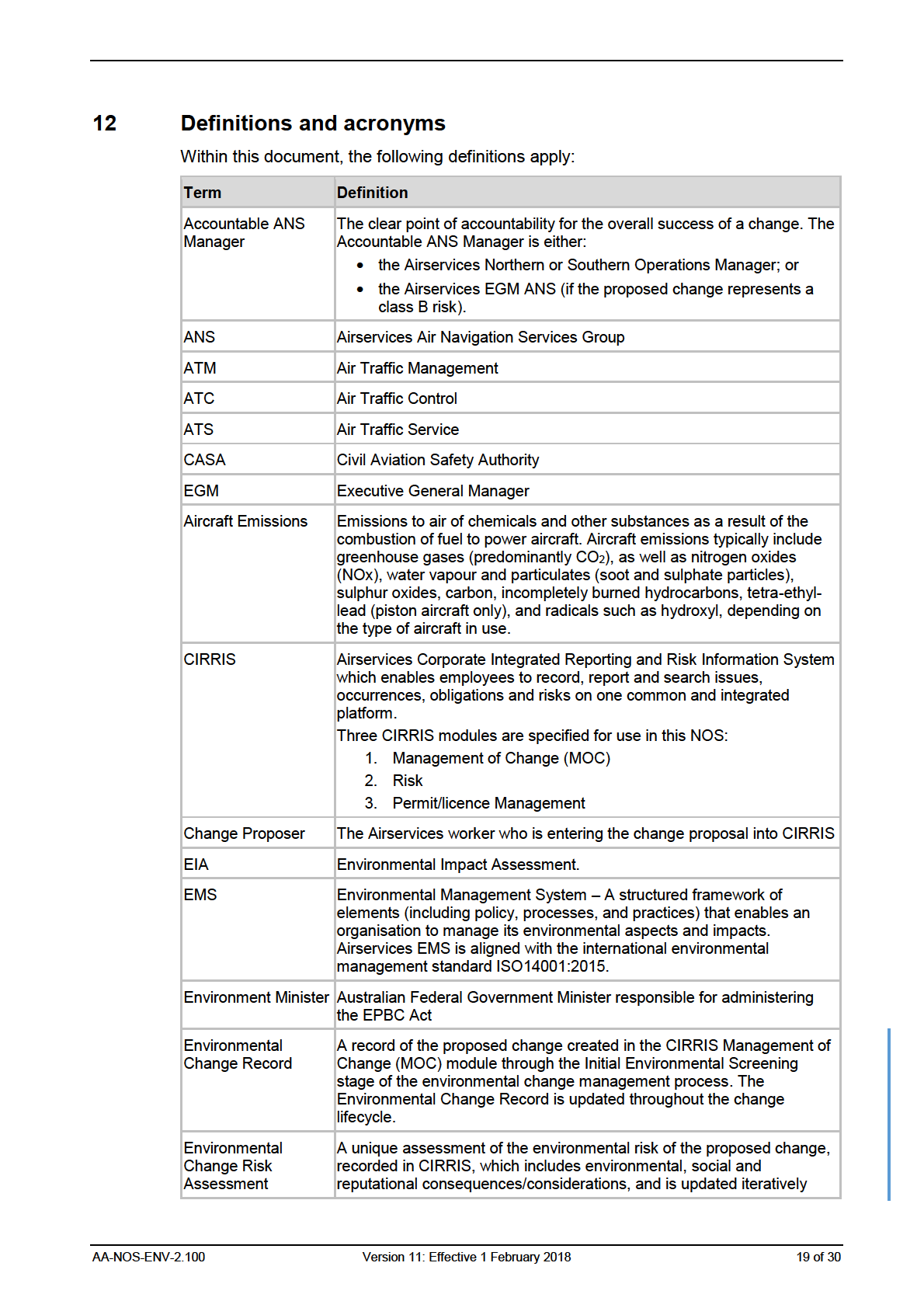
FOI 24-31 - Doc 4
pursuant to the Freedom of Information Act 1982 by Airservices Australia
Released
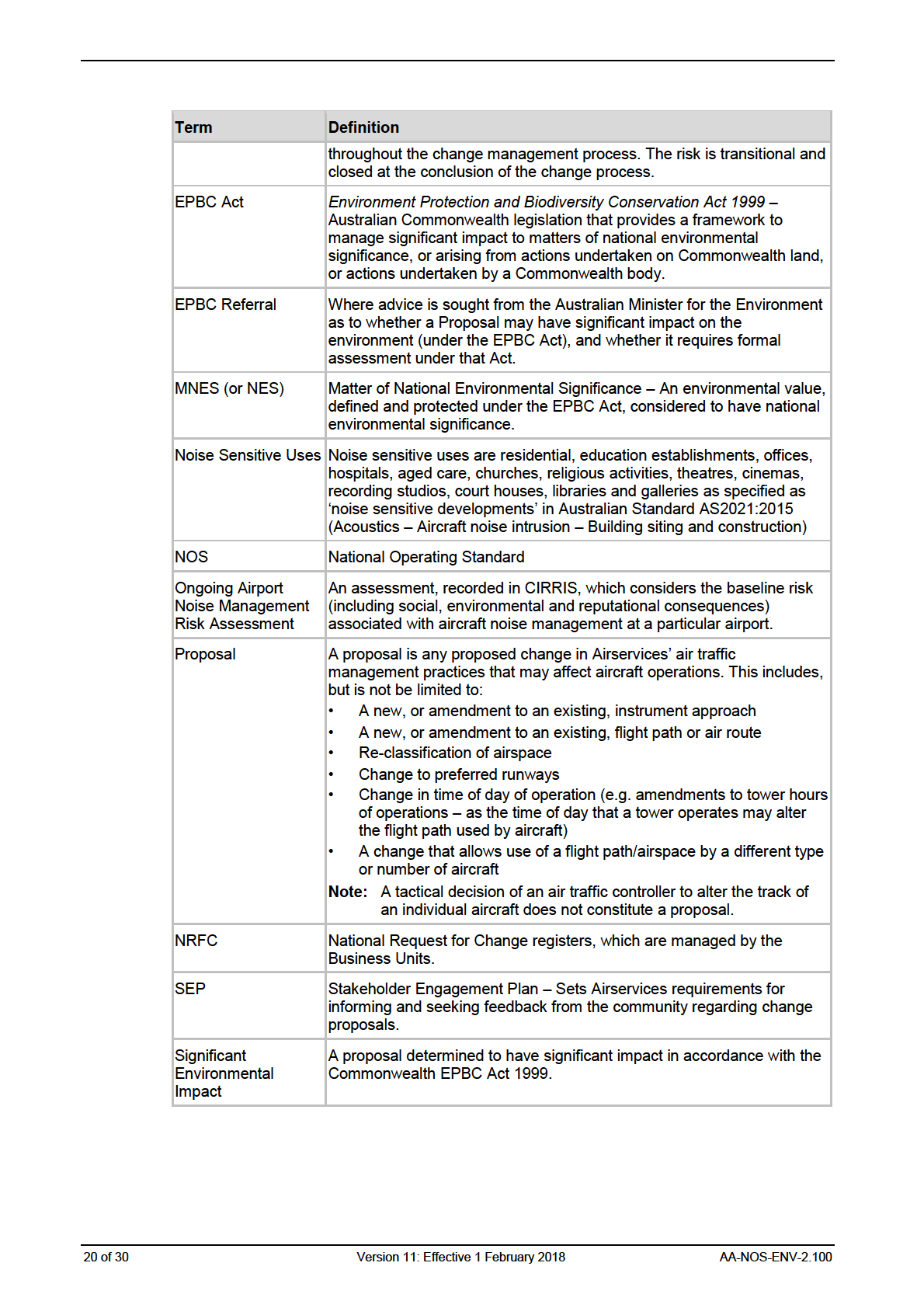
FOI 24-31 - Doc 4
pursuant to the Freedom of Information Act 1982 by Airservices Australia
Released
FOI 24-31 - Doc 4
13
References/related documents
13.1
Internal documentation
•
Airservices Environment Policy: C-POL0030
•
Airservices Risk Management Standard: AA-NOS-RISK-0001
•
Airservices Environmental Risk Management Procedure: ENV-PROC-0004
•
Airservices Environmental Management System Objectives and Requirements –
AA-NOS-ENV-0001
•
Airservices Communication and Consultation Protocol -
http://www.airservicesaustralia.com/wp-content/uploads/Communication-and-
Consultation-Protocol WEB.pdf
13.2
External documentation
•
SEWPaC 2010, ‘Actions on, or impacting upon, Commonwealth land, and actions
by Commonwealth agencies’ Significant impact guideline 1.2, Environment
Protection and Biodiversity Conservation Act 1999.
•
AS2021-2000: Acoustics – Aircraft noise intrusion – Building siting and
Construction, Standards Australia International Ltd, Sydney, NSW 2000.
•
Former Commonwealth Department of Transport and Regional Services
(DOTARS), Discussion Paper ‘Expanding ways to describe and assess aircraft
noise’ (March 2000).
•
Transport Noise Management Code of Practice – Volume 1 Road Traffic Noise,
Queensland Department of Transport and Main Roads, 2013.
pursuant to the Freedom of Information Act 1982 by Airservices Australia
Released
AA-NOS-ENV-2.100
Version 11: Effective 1 February 2018
21 of 30
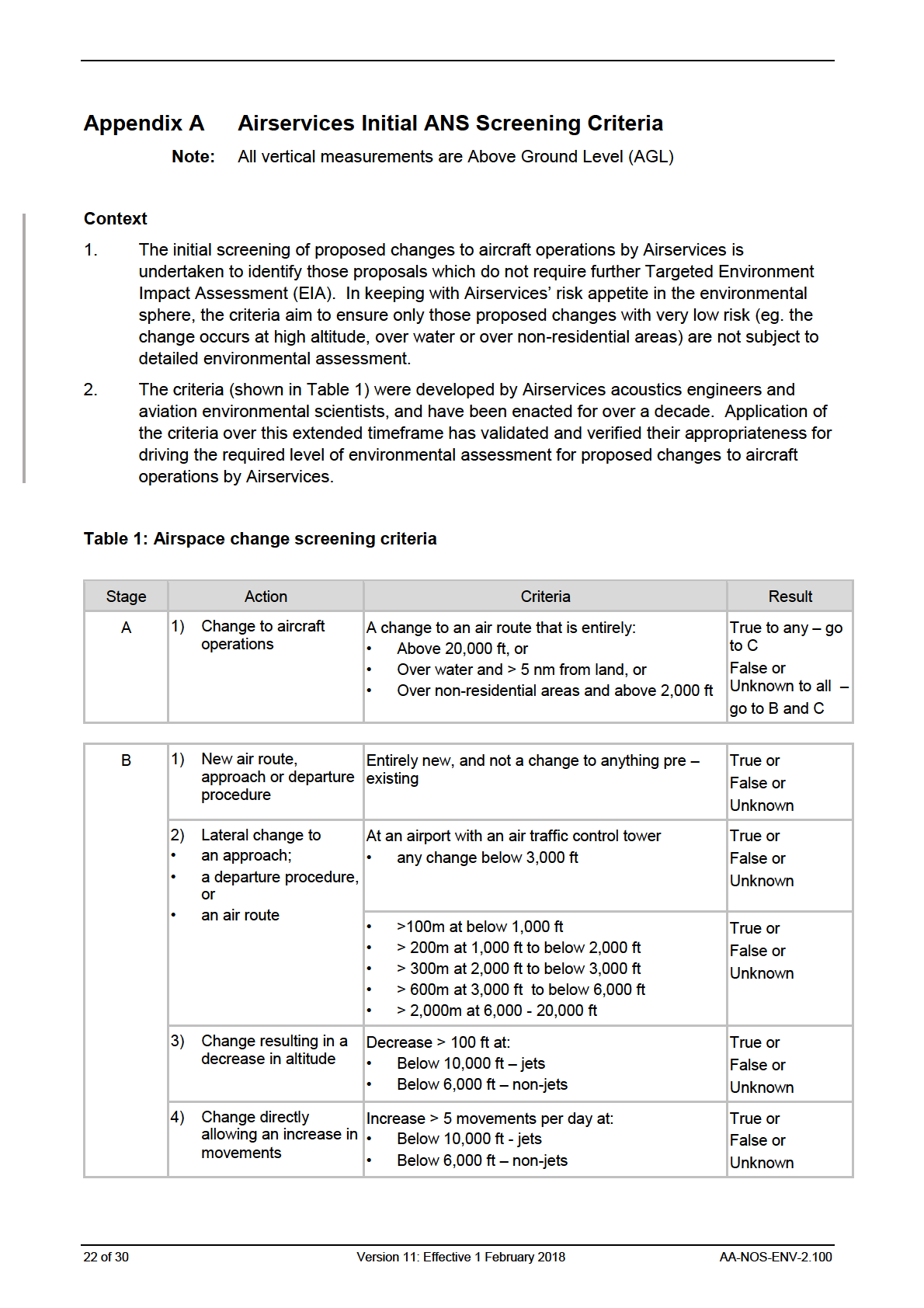
FOI 24-31 - Doc 4
pursuant to the Freedom of Information Act 1982 by Airservices Australia
Released
FOI 24-31 - Doc 4
5) Change in hours of
A change directly allowing a departure or arrival
True or
operation
time within the hours between 10pm – 7am
False or
Unknown
6) Change in aircraft type A change directly allowing a different type or
True or
category of aircraft to use a given route
False or
Unknown
7) Change in distance
Increase > 100 nm
True or
flown
C
False or
Unknown
Applying the initial screening criteria:
1.
Screening criteria may only be applied by people who have undergone appropriate training
in the use of, and basis for, the criteria.
2.
For the purposes of initial screening, residential areas are identified through analysis of
aerial photographs and/or satellite imagery for residences or communities underneath or
close to the flightpath. If uncertain, this should be marked as ‘unknown’ or Airservices Noise
and Environment (N&E) Team can be contacted for advice.
3.
Average traffic levels may be applicable at locations where there is little variation in
movements throughout the year. Consideration shall be given to locations that host special
events attracting additional movements such as air shows.
Screening Outcome
1. Proposals shall undergo Targeted EIA where application of the screening criteria
indicates a ‘True’ or ‘Unknown’ result, for any of the criteria at Stages B and C in
Table 1 (i.e. may result in environmental impact).
pursuant to the Freedom of Information Act 1982 by Airservices Australia
Released
AA-NOS-ENV-2.100
Version 11: Effective 1 February 2018
23 of 30
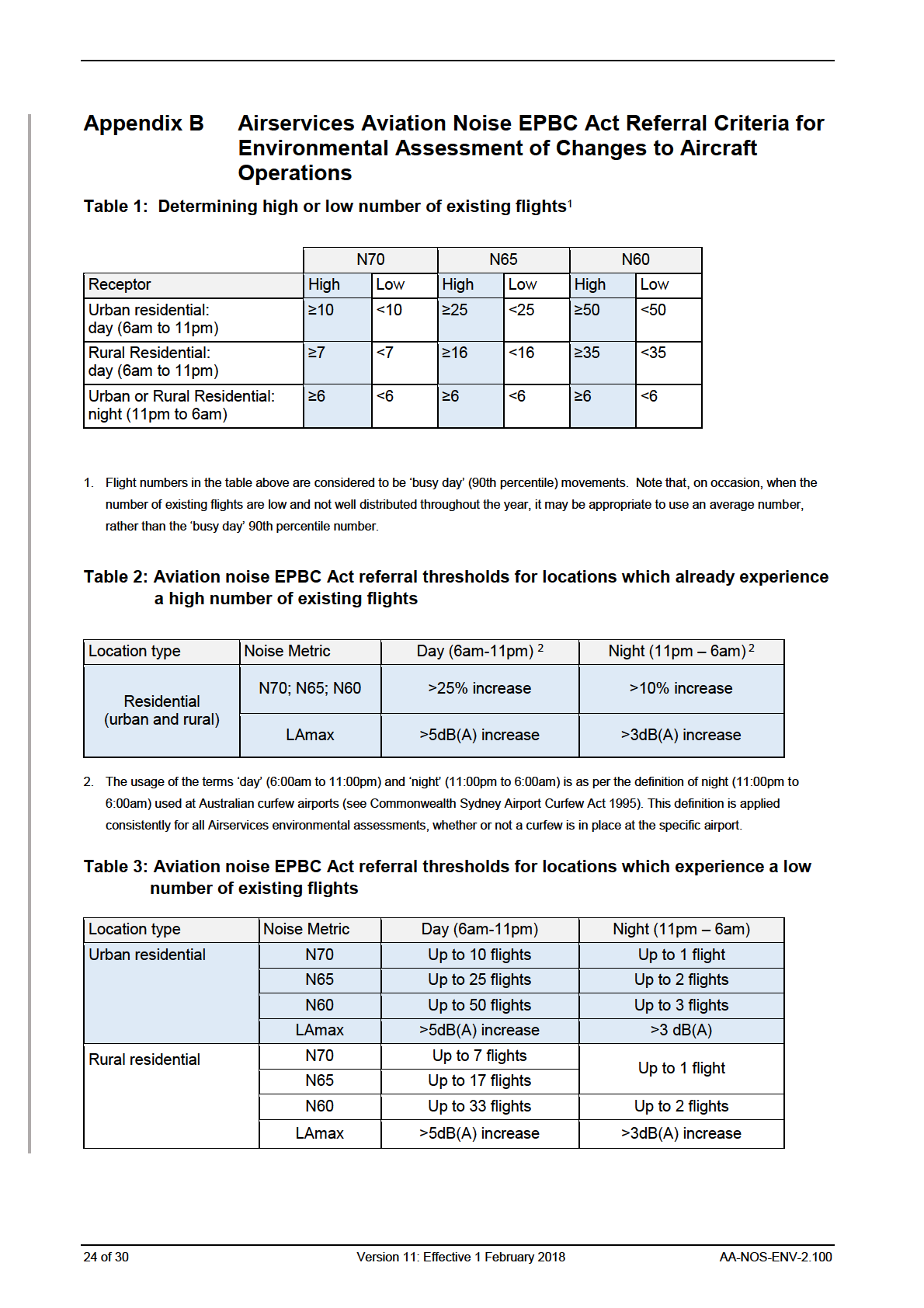
FOI 24-31 - Doc 4
pursuant to the Freedom of Information Act 1982 by Airservices Australia
Released
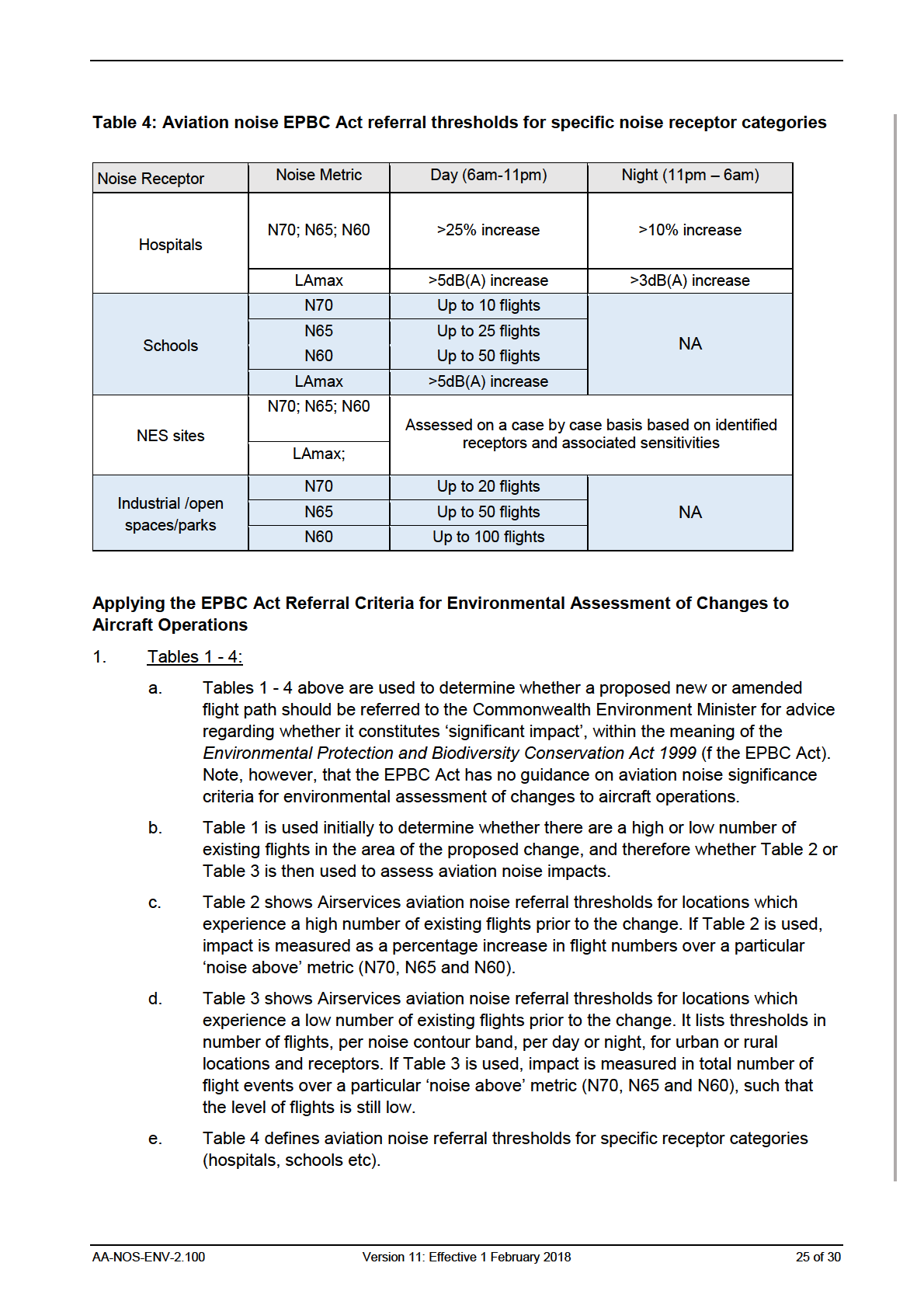
FOI 24-31 - Doc 4
pursuant to the Freedom of Information Act 1982 by Airservices Australia
Released
FOI 24-31 - Doc 4
2.
Steps in Applying Tables 1 - 4:
Step 1
Using Table 1, identify whether the existing number of flights is “high” or
“low”. For a high number of existing flights (day or night criteria), Table
2 must be used to determine the potential significance of any aviation
noise impacts, while a low number of existing flights must use Table 3.
Step 2
Identify the relevant aviation noise receptors for the proposed change
(urban residential, sensitive – school, etc).
Step 3
From available data, identify the number of flights currently using the
existing flight path for the applicable noise metric (N70 and/or N65
and/or N60), for day and/or night times, as per the operating times of
the existing flights.
Step 4
Identify how many flights will use the flight path as a result of the
proposed change for the applicable noise metric (N70 and/or N65
and/or N60) for day and/or night, as per the operating times of the
flights associated with the proposed change.
Step 5
Using either Table 2 or Table 3, as determined at Step 1, read across to
determine whether the increased number or noise metric of flights in the
change proposal, in any contour, exceeds stated thresholds for the
relevant receptor.
Step 6
Consider the additional criteria in Table 4 to determine if noise
thresholds for noise receptor categories are exceeded.
Step 7
If any criteria are exceeded, and the change is planned to proceed in its
current form, then the change should be referred to the Commonwealth
Environment Minister for advice and a determination of whether it
constitutes ‘significant impact’ (as per the requirements of the EPBC
Act).
Context and Considerations
1.
The Airservices Aviation Noise EPBC Act Referral Criteria for Environmental Assessment of
Changes to Aircraft Operations (the Referral Criteria) establish a range of threshold levels
for key noise metrics, below which aircraft noise arising from a proposed change is
considered highly unlikely to represent ‘significant impact’, as defined under the EPBC Act.
2.
Where assessments indicate that a proposed change may result in noise levels exceeding
these thresholds, and the change is planned to proceed in its current form, the proposal
shall be referred to the Commonwealth Environment Minister for advice (known as an
‘EPBC Act Referral’) and a determination on whether it constitutes significant impact.
pursuant to the Freedom of Information Act 1982 by Airservices Australia
3.
The Referral Criteria were developed giving consideration to relevant published literature
including AS2021:2015 (Acoustics – Aircraft noise intrusion – Building siting and
construction), the National Safeguarding Airports Guidelines (NASAG), and the (then)
Commonwealth Department of Transport and Regional Services (DOTARS) discussion
paper entitled ‘Expanding ways to describe and assess aircraft noise’ (March 2000).
Released
4.
The rationale behind Airservices key noise metrics and the Referral Criteria thresholds is
provided below:
a.
Noise Metrics
i. ‘Number Above’ metrics (N70, N65 and N60).
26 of 30
Version 11: Effective 1 February 2018
AA-NOS-ENV-2.100
FOI 24-31 - Doc 4
‘Number Above’ metrics (also known as ‘N Contours’) are an aircraft noise
characterisation mechanism used to map noise ‘zones’ around an aerodrome.
Number above metrics show the number of noise events above a given noise
level (for example, N70 contours would show the number of aircraft noise
events greater than 70dB(A)).
Application of the Referral Criteria to a particular change, entails a comparison
of existing N contour events around a given airport, with those represented by
the change. The change in events can either be expressed as a percentage
increase over the current state, or up to a total numbers of flights (refer to ‘b’
below for further details).
Why N70, N65 and N60?
In March 2000, the (then) Commonwealth Department of Transport and
Regional Services (DOTARS) released a discussion paper entitled ‘Expanding
ways to describe and assess aircraft noise’.
70 dB (A) and N60 dB(A) were identified as suitable levels for describing
noise impacts given that:
o
70dB (A) is considered to be the external sound level below which no
difficulty with reliable communication from radio, television or
conversational speech is expected in a typical room with windows open.
o
60 dB(A) equates to the indoor design guide level of 50 dB(A) specified
in AS2021:2015 Acoustics – Aircraft noise intrusion – Building siting and
construction.
In addition to N70 and N60, Airservices uses N65 when required to improve
granularity of change characterisation (as an intermediate threshold between
N70 and N60).
ii. LAmax.
In addition to N contours, LAmax is used to describe the potential noise
increase (expressed in dB(A)) represented by the proposed change.
LAmax represents the loudest noise level of a single flight by a specific type of
aircraft.
b.
Referral thresholds (percentage noise increase, total flight numbers, and noise
levels in dB(A))
i.
Percentage noise increase, and increase in total flight numbers.
These thresholds were devised by Airservices aviation noise and
environmental specialists and acoustics engineers, based on qualitative
pursuant to the Freedom of Information Act 1982 by Airservices Australia
estimates of levels of noise below which there is minimal risk of a change
resulting in significant impact under the EPBC Act (in the absence of
published, defined criteria for these metrics). The thresholds are above what
would be expected to be experienced through normal growth in aviation traffic
in Australia.
Released
ii.
LAmax.
Thresholds for these metrics are based on published literature1 regarding how
perceptible noise changes (expressed in dB(A)) are to the human ear, as
follows:
AA-NOS-ENV-2.100
Version 11: Effective 1 February 2018
27 of 30
FOI 24-31 - Doc 4
o
Changes of up to 3dB(A) – not likely to be perceptible.
o
Changes between 3dB(A) and 5dB(A) – may be perceptible.
o
Changes between 5dB(A) and 10dB(A) – likely to be perceptible.
1. Transport Noise Management Code of Practice – Volume 1 Road Traffic Noise, Queensland Department of Transport and Main
Roads 2013.
5.
Validation of the Referral Criteria
The noise metrics and thresholds described in the Referral Criteria have been used by
Airservices in aviation noise impact assessments from 2013 to the present, over which time
their appropriateness for identifying potential ‘significant impact’ has been validated
through:
a.
Discussion of changes being implemented at Community Aviation Consultation
Group (CACG) meetings at airports around Australia;
b.
Ongoing analysis of aviation noise complaint data, and associated flight path
changes, from Airservices’ Noise Complaints Information Service (NCIS);
c.
Consultation with stakeholders (including the Aviation Noise Ombudsman and the
Commonwealth Department of Infrastructure and Regional Development) regarding
noise complaints and noise impact assessments;
d.
A referral to the Commonwealth Department of Environment, under the EPBC Act,
for Airservices Gold Coast Airport Instrument Landing System (ILS) Project (which
included discussion of the Referral Criteria and associated methodology to assess
potential significance of aviation noise impacts).
Over 200 airspace changes have been successfully assessed for potential aviation noise
impacts and implemented by Airservices since inception of the Referral Criteria in 2013,
without later being found to represent ‘significant impact’ under the EPBC Act. Given this
result, and the significant traffic growth experienced in Australia since 2013, the current
Referral Criteria threshold levels are considered by Airservices to be appropriate and
relatively conservative.
Referral Criteria Definitions
o LAmax: A maximum A-weighted sound pressure level in a given stated interval (see
AS2021:2015).
o ‘Number Above’ metrics (i.e. N70, N65 and N60) – Noise characterisation mechanisms
used to map noise ‘zones’ around an aerodrome, showing the number of noise events
pursuant to the Freedom of Information Act 1982 by Airservices Australia
above a given noise level (i.e. 70dB(A), 65dB(A) and 60dB(A)). For example, N70 contours
would show the number of aircraft noise events greater than 70dB(A).
(For further information refer to:
https://infrastructure.gov.au/aviation/environmental/transparent noise/expanding/4.aspx)
Released o Commonwealth Matters of National Environmental Significance (MNES) sites: sites which
represent Matters of National Environmental Significance – as listed in the EPBC Protected
Matters Search Tool.
28 of 30
Version 11: Effective 1 February 2018
AA-NOS-ENV-2.100
FOI 24-31 - Doc 4
o Sensitive sites are considered by Airservices to be schools, hospitals and churches, due to
increased vulnerability of occupants to the negative effects of aviation noise.
o Urban residential and rural residential areas are determined based on searches of relevant
State or Territory Land-Use and Planning Tools.
pursuant to the Freedom of Information Act 1982 by Airservices Australia
Released
AA-NOS-ENV-2.100
Version 11: Effective 1 February 2018
29 of 30
FOI 24-31 - Doc 4
Appendix C
Other Business Revenue – explanatory notes
Other Business Revenue (OBR), otherwise referred to as ‘Unregulated Revenue’ or
Non-Airways Revenue, relates to the provision of goods or services other than those
which are provided by Airservices as part of the regulated service that is subject to the
Long Term Pricing Agreement (LTPA) with customers. For the avoidance of any doubt,
OBR is a term applied to account for those Airservices activities not funded through
Airways Revenue.
Airservices OBR includes (but is not limited to):
provision of charting services and other publications
maintenance or provision of navaids under contract
provision of air traffic services under contract (eg. for Solomon
Islands and Nauru)
delivery of training, and
funds received by Airservices for official development assistance
(aid) activities.
For further information on OBR, refer to the following documents:
C-PROC0194
MI-0205
pursuant to the Freedom of Information Act 1982 by Airservices Australia
Released
30 of 30
Version 11: Effective 1 February 2018
AA-NOS-ENV-2.100










